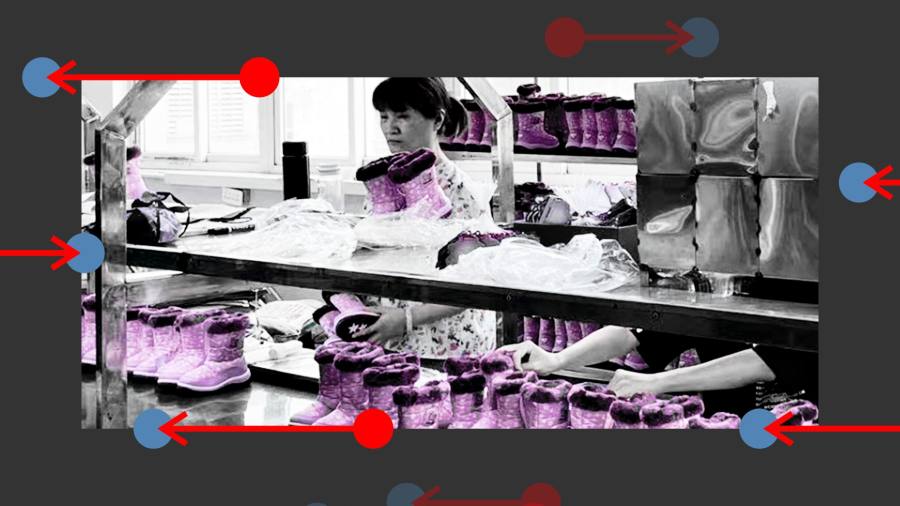Sign up for free updates on Chinese business and finance.
Receive a daily email summarizing the latest news in Chinese business and finance.
China’s manufacturers are currently facing challenging times due to various factors such as global demand slowdown, geopolitical tensions, and a cautious post-pandemic recovery. This article examines the struggles experienced by three factories in different industries, showcasing the overall slowdown in the world’s second-largest economy.
Factory activity, which played a vital role in economic growth during the pandemic, has been declining for four consecutive months until July 31. The Chinese Communist party’s politburo has acknowledged the challenging economic situation since the lifting of pandemic restrictions and has announced measures to stimulate domestic demand, particularly consumer spending. Alicia García-Herrero, chief Asia-Pacific economist at Natixis, describes the current situation as “pretty bad,” emphasizing the need for a significant stimulus to revive domestic demand as a whole.
President Xi Jinping’s focus on “high-quality” growth adds complexity to the situation, as tech industries are prioritized over traditional manufacturing hubs. This shift in strategy has a significant impact on manufacturers like Feng Tai Footwear, which specializes in low-technology consumer goods. The company’s CEO, Eddie Lam, reveals the misery faced by the sector, with a decline in orders and insufficient budgets from buyers. Despite the hardships, Lam is hopeful for growth opportunities in China’s domestic market and emerging markets under the Belt and Road initiative.
While some companies consider relocating factories outside of China, Feng Tai has no immediate plans to do so, as Lam believes the United States recognizes the risks of decoupling from China. Lam highlights the disadvantages of moving production to Southeast Asia, including higher supply chain costs and additional investments.
Geopolitical tensions between Beijing and Washington, along with disruptions in the supply chain caused by the pandemic, have prompted more manufacturers to diversify their operations outside of China. Tien Sung Group, a family business involved in garment manufacturing for global brands, has been implementing a “China plus one” strategy for over a decade. Managing director Rex Ho emphasizes the need to spread risks and avoid over-reliance on a single manufacturing location. The company has already established factories in Vietnam and Cambodia, along with its existing base in China.
Ho mentions that 80% of their revenue comes from exports to Europe and the US, and clients are increasingly concerned about products labeled “made in China.” He attributes this shift to both geopolitical tensions and labor costs, with lower wage rates in countries like Cambodia and Vietnam. However, moving production outside of China does not offer complete protection from the challenges of the global economy, as some of Ho’s peers have experienced order declines and payment extensions due to excess inventory and rising interest rates.
In the realm of high-end manufacturing development, electronic components manufacturers like Anhui Tiger have seen tremendous growth due to President Xi’s focus on this sector. Anhui Tiger, based in Hefei, specializes in producing electronic parts for industries such as automotive and clean energy. Despite fluctuations in demand for consumer electronics, the company has experienced significant growth during the pandemic, particularly in sectors related to clean and renewable energy. As a result, there has been a surge in China’s industrial production of electrical equipment and machinery.
Although Anhui Tiger is performing well in its current state, pressure to expand outside of China remains due to client demands. The company is in the process of setting up its first plant in Vietnam to respond to such demands. This highlights the overall trend among Western companies, which heavily rely on Chinese equipment and products for their clean energy transition.
In conclusion, China’s manufacturers are navigating through a challenging period characterized by declining global demand, geopolitical tensions, and a cautious recovery from the pandemic. While some manufacturers face difficulties, others in high-end manufacturing sectors are experiencing growth. Additionally, the pressure to diversify and expand operations outside of China is becoming a common trend among manufacturers due to various factors.
Denial of responsibility! VigourTimes is an automatic aggregator of Global media. In each content, the hyperlink to the primary source is specified. All trademarks belong to their rightful owners, and all materials to their authors. For any complaint, please reach us at – [email protected]. We will take necessary action within 24 hours.


